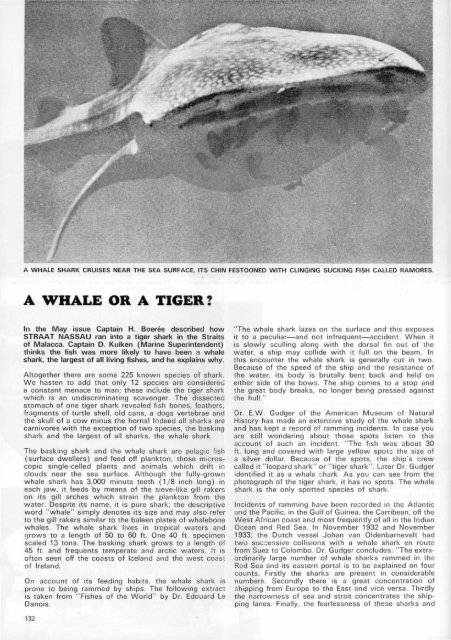You also want an ePaper? Increase the reach of your titles
YUMPU automatically turns print PDFs into web optimized ePapers that Google loves.
A WHALE SHARK CRUISES NEAR THE SEA SURFACE, ITS CHIN FESTOONED WITH CLINGING SUCKING FISH CALLED RAMORES.<br />
A WHALE OR A TIGER!<br />
In the May issue Captain H. Boeree described how<br />
STRAA T NASSAU ran into a tiger shark in the Straits<br />
of Malacca. Captain D. Kuiken (Marine Superintendent)<br />
thinks the fish was more likely to have been a whale<br />
shark, the largest of all living fishes, and he expla!ns why.<br />
A ltogether there are som e 225 know n species of shark.<br />
We hasten to add t hat only 12 species are considered<br />
a constant menace to man; t hese inc lude t he t iger shark<br />
w hich is an undiscriminating scavenger. The dissected<br />
st omach of one tiger s hark revealed fish bones. feathers.<br />
fragments of turtle shell, old ca ns. a dogs vertebrae and<br />
the skull of a cow minus the horns! Indeed all sharks are<br />
carnivores w ith t he exception of two species, the basking<br />
s hark and the largest of all sharks, t he w hale shark.<br />
The basking shark and the w hale shark are pelagic fis h<br />
(surface dwellers) and feed off plankton, those mic roscopic<br />
single-celled plants and animals w hich drift in<br />
c louds near t he sea surface. A ltho ugh the fully-grown<br />
w hale shark has 3,000 minute teeth ( 1 / 8 inc h long) in<br />
each jaw, it feeds by means of t he sieve-like gill rakers<br />
on its gill arc hes w hic h strai n the plankton from the<br />
water. Despite its nam e, it is pure shark; t he descriptive<br />
word "whale" simply denotes its size and may also refer<br />
to the gill rakers similar to the baleen plates of w halebone<br />
w hales. The w hale shark lives in t ropical waters and<br />
grows to a length of 50 to 60 ft. One 40 ft . specimen<br />
scaled 13 tons. The basking shark grows to a lengt h of<br />
45 ft. and frequents temperate and arctic waters. It is<br />
often seen off t he coast s of Iceland and t he west coast<br />
of Ireland.<br />
On account of its feeding habits. the w hale shark is<br />
prone to being rammed by ships. T he following extract<br />
is taken from " Fi shes of the World" by Dr. Edouard Le<br />
Dano is.<br />
132<br />
" The w hale shark lazes on the surface and this exposes<br />
it to a peculiar- and not infreq uent- accident. W hen it<br />
is slowly sculling along with the dorsal fin out of the<br />
water, a ship may collide with it full on the beam. In<br />
this encounter the whale shark is generally cut in two.<br />
Because of the speed of the ship and the resistance of<br />
t he water, its body is brutally bent back and held on<br />
either side of the bows. T he ship comes to a stop and<br />
the great body breaks, no longer being pressed against<br />
the hull."<br />
Dr. E.W . Gu dger of the American Museum of Natural<br />
History has made an extensive study of the whale shark<br />
and has kept a record of ram m ing incidents. In case you<br />
are still wondering about t hose spots listen to t his<br />
account of such an incident. "The fish was nbout 30<br />
ft. long and covered w ith large yellow spots the size of<br />
a silver dollar. Because of the spots, the ship 's crew<br />
called it " leo pard shark " or "tiger shark". Later Dr. Gudger<br />
ident ified it as a whale shark. As you can see from the<br />
photograph of the tiger shark, it has no spots. The whale<br />
shark is the only spotted species of shark.<br />
Incidents of ramming have been recorded in the Atlantic<br />
and the Pacific, in the Gulf of Guinea, the Carribean, off the<br />
West African coast and most frequently of all in the Indian<br />
Ocean and Red Sea. In November 1932 and November<br />
1933, the Dutch vessel Johan van Oldenbarnevelt had<br />
two suc8essive collisions with a whale shark en route<br />
from Suez to Colombo. Dr. Gudger concludes: " The extraordinarily<br />
large number of whale sharks rammed in the<br />
Red Sea and its eastern portal is to be explained on four<br />
counts. Firstly t he sharks are present in considerable<br />
numbers. Secondly there is a great concentration of<br />
shipping from Europe to the East and vice versa. Thirdly<br />
the narrowness of sea and strait concentrates the shipping<br />
lanes. Fi nally, the fearlessness of these sharks and
















